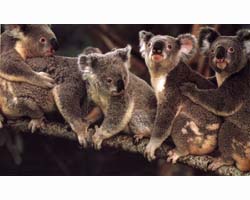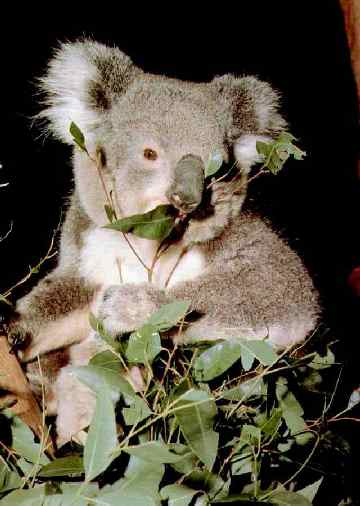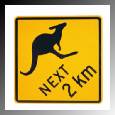

Phascolarctus cinereus
Koalas have not always been revered. From the late 1870's, hundreds of thousands were slaughtered for their pelts until hunting was banned in 1927.
Baby koalas are no bigger than a grape (25mm or 1 inch) when they are born in December (start of Summer) and crawl into their mother's pouch to develop.
Koala babies spend the southern Autumn inside their mother's pouch, attached to a teat.
At five months old, the baby koala's eyes open and they begin to peer out of the pouch. The mother weans her youngster on "pap" which the mother produces from digested leaves and excretes at intervals instead of her normal droppings, when it is five months old.
Click here to say a large (74k) but beautiful photograph of a mother koala with her very young joey.
After six to seven months, infant koalas first leave the pouch - when they are too large for the pouch, they are carried on the mother koala's back, although they can move about on their own.
At about seven months old, it starts to nibble leaves itself, although it is not fully weaned until 11-12 months old.
A young koala will ride on its mother's back until it is one year old.
A female koala bears a single baby five weeks after mating.
By the time they are two years old, koalas are fully independent and the mother will give birth again.

Koalas are slow moving, tailless, usually with grey fur. Koalas are an arboreal marsupial and, consequently have strong, sharp claws intended for climbing rather than aggression.
The koala avoids human habitations and spends most of its time high in eucalypt (gum) trees. Although they are night-time feeders (feeding almost entirely on the leaves of eucalyptus trees) they sometimes move from tree to tree during the day and can be seen on bushland roads.
A badger-sized adult eats about 450g (1lb) of food each day. Because the eucalyptus's tough leathery leaves are difficult to digest, the koala has a special offshoot from its gut that breaks them down. This offshoot, similar to a human appendix but longer, also produces pap on which the mother begins weaning her youngster when it is five months old.

Weight: Male 6-12kg (14-26.5 pounds); female 5-11kg (11-24 pounds).
Lifespan: A koala's lifespan can reach 20 years.
As koalas can sleep up to 19 hours a day, many people believe they are gentle, quiet creatures. However, they can lash out with their claws at each other or at humans who try to catch them - not from malice but in panic, clinging as they would to a tree trunk.
To help a koala grip trunks and branches effectively, it has a second 'thumb' -
an index finger that can oppose its other fingers.
Koalas bellow loudly each September (Spring) signalling the start of the breeding season. It is a fearsome sound, sometimes audible several kilometres away and warns young males of a dominant male's presence - the sound also helps females find a mate.
Mating peaks in December. Males, fully mature at five years old, compete noisily and scent-mark trees with oil from a chest gland.
Koalas are found throughout Queensland, New South Wales, Victoria and a small area in South Australia - in other words, on the eastern side of Australia (specifically, not in WA, NT, Tas. and only a very small portion of southern South Australia).

Australian Animals - Wildlife Index


Page background created by
